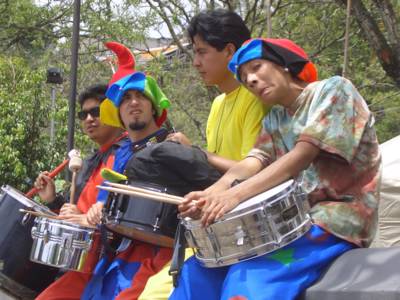We visited the Old Cathedral by accident during one of our Spanish lessons. We were touring La Casa De Las Palomas with Raul, our Spanish instructor. One of the men working there showed an interest in us and proceeded to explain some of the architectural features of the historic building. He was an expert in architectural restoration and wanted to show us the work he was doing in the Old Cathedral. The Old Cathedral has been under restoration for a couple of years now and has been closed to the public during this time. We jumped at the opportunity.
In Cuenca, they were masters in the architecture of deception. For instance, in one area of the church, there were some real pillars adjacent to some pillars that were merely painted on the wall. At first, I didn't even notice that they were merely paintings.
We learned something about the difficult decisions encountered during restoration. One wall had been painted over with 17 different murals. The hard question - which one should be restored? The building was constructed in 1557, so these murals were from many different time periods. Should they restore the most recent? Should they consider the very first mural the most authentic and stick with that one? Should they restore the church to one time period to maintain consistency? Should they restore a small part of several of the murals, thus capturing more history? Many possibilities; no one correct answer.
Since I am a mere traveler and not an expert in architectural restoration, the question that struck me was "Why did they bother with so many murals?" If one mural cracked or faded, why not just whitewash it or add a splash of color?
Another interesting aspect of this church is that its foundation was built with stones cut during the Inca period. Even the casual observer can see the difference in the fine mason work of the Incas compared to the stonework of prior and subsequent periods. Cuenca is located just west of the site of the old Incan town of Tomebamba. The Spanish churches use stones looted from Tomebamba as part of their foundations. The restorers have intentionally left some of these stones uncovered to show the different foundations used.
There is a religious counterpart to the physical construction of Spanish architecture over Incan stonework. For example, many holidays have their roots in indigenous celebrations that are hundreds of years old. Festivals of patron saints often originated as indigenous feast days. When the Spanish arrived, these celebrations were melded with religious celebrations.
In Cuenca, the Christian holiday, All Soul's Day, precedes the indigenous holiday, Day of the Dead, which precedes the civic Cuencan Independence Day - on November 1, 2, and 3. This year they all come right after a weekend making for a prolonged celebration. The New Cathedral opens it's crypts to the public on one day of the year, November 2, which is, coincidentally, the Day of the Dead.
Celebrations include beauty pageants, parades, music, dancing, artisan fairs, indigenous burial rituals, Catholic masses, "traditional" foods, historical dramatizations, and lots of drinking. I am told that in many ways, Latin American religious practice reflects a showy Catholic facade over centuries-old indigenous beliefs and customs.
During today's celebrations, I passed some street musicians on stilts dressed in colorful jester costumes.

|

|

|


No comments:
Post a Comment